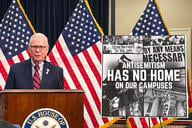You have /5 articles left.
Sign up for a free account or log in.
ORLANDO -- Early Sunday morning here, University of Central Florida officials responded to a residence hall fire alarm call that ended with an evacuated building and a former student's suicide. In his dorm room, they found explosives, guns and a shocked roommate who'd barricaded himself in the bathroom and called 911 after he'd been held at gunpoint. Police said they found writings indicating the former student had planned a campus attack.
A few hours later, on the other side of town, the annual conference of NASPA: Student Affairs Professionals in Higher Education, got under way. The events of the morning were a grim reminder of the realities that can send a campus into turmoil, and that these practitioners have to live with.
They also underscored one of the first points made at a presentation late Monday afternoon on problem-based learning in emergency preparedness training. Reviewing the three stages of crises, Jennifer Nailos, a doctoral student in higher education and student affairs at Indiana University at Bloomington, noted that prevention is less studied than are response and recovery.
"We like to live in a utopian society and believe we don't have to worry about it," Nailos said. Not the most effective approach to preparing for a crisis.
Nailos and Kristin McGowan, a residence hall coordinator at the University of Texas at Austin, have been revamping emergency preparedness training in the dorms there to ensure that student resident advisers and professional staff are not making that mistake.
In spring 2012, they audited the residence halls' emergency preparedness. Part of this involved talking to staff members to get a sense of whether they understood crisis protocol. (Nailos moved from Texas to Bloomington last year.) They found a general lack of confidence in knowledge, with staff struggling to know whom to contact in an emergency, limited problem solving ability, and a desire to learn more about "everything" when asked for "specific" areas in which employees might like more training.
"There was a haze, of not feeling like they could enact i don't think you enact responsibilities ... if she said this, i'd probably paraphrase ... dl *** this was the terminology they were using so it might be an emergency prep/student affairs thing... -ag some of their responsibilities or recall their duties," Nailos said.
But after hearing from staff members that they preferred a hands-on learning style, Nailos and McGowan wanted to do more than just distribute new materials or host a webinar. So they turned to problem-based learning, in which RAs and staff were broken up into small groups where they walked through different scenarios, acting them out and discussing (for the students) their specific responsibilities and (for the professional staff) what everyone should know and do.
An example scenario posed to the NASPA audience: It's 9:30 on a Tuesday night and you're off-campus at dinner, when you get a call from the front desk RA. Severe weather has knocked out electricity and two students are stuck in an elevator.
What are your first points of action? What modes of communication do you have? What necessary information do you have readily available and where is it? What information do you share with staff, supervisors and residents during the outage, and how? Whom do you call in to help while you're returning to campus? And what do you communicate to residents and staff once power is restored?
"Preparing for [crises] is incredibly difficult, because it could range from a natural disaster," Nailos said, "through an assault, bomb threat, fight, suicide. The spectrum is incredibly wide, so adequate training in each area could take a lifetime."
But the Texas officials found promising results in their follow-up surveys. Students and staff demonstrated more confidence in understanding scenarios and terminology, and in their confidence to act should something actually happen.
The less interactive part of the audit dealt with gathering and evaluating the documents, information and resources for emergency preparedness in the dorms. They found variation between the eight residence halls, where 161 RAs and 30 professional workers are employed. So they standardized all the language, creating new charts breaking down on-call problem solving processes and different things to know in case a lockdown, shelter-in-place, not sure what 'shelter-in-place' is ... should i? *** it just means take immediate shelter. it's another emergency term -ag or evacuation scenario emerges. All of the 24-hour residence hall desks now have bulletin boards with all this information easily accessible and up to date.
But the key to Texas' program is active learning, not just handing out some pamphlets and calling it done. Their approach encourages critical thinking -- on your feet, at that -- because crises never unfold the same way twice. (Staff members also said they want training at least once a semester, if not more often. Besides keeping this fresh in people's minds, it also addresses the fact that about half of RAs turn over annually.)
"They could address the questions they had, instead of us saying, tell me the correct answer," McGowan said in an interview after the presentation. "The goal of all of this is that they're not scrambling after an event.... They're ready to respond when needed."




